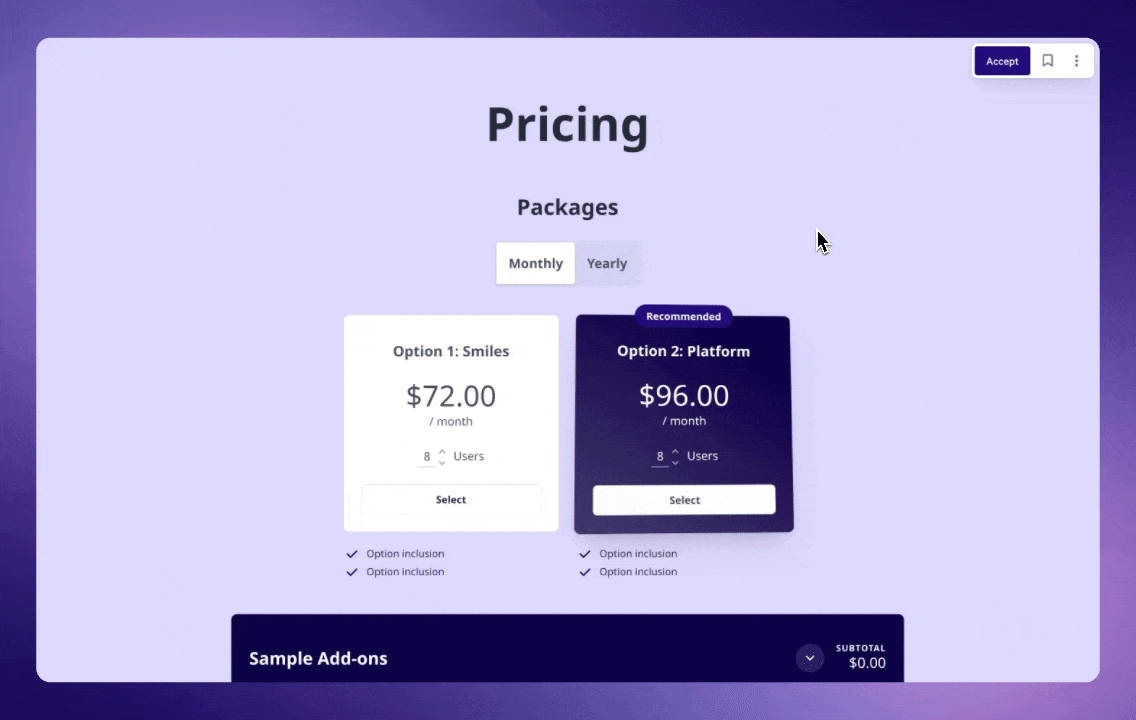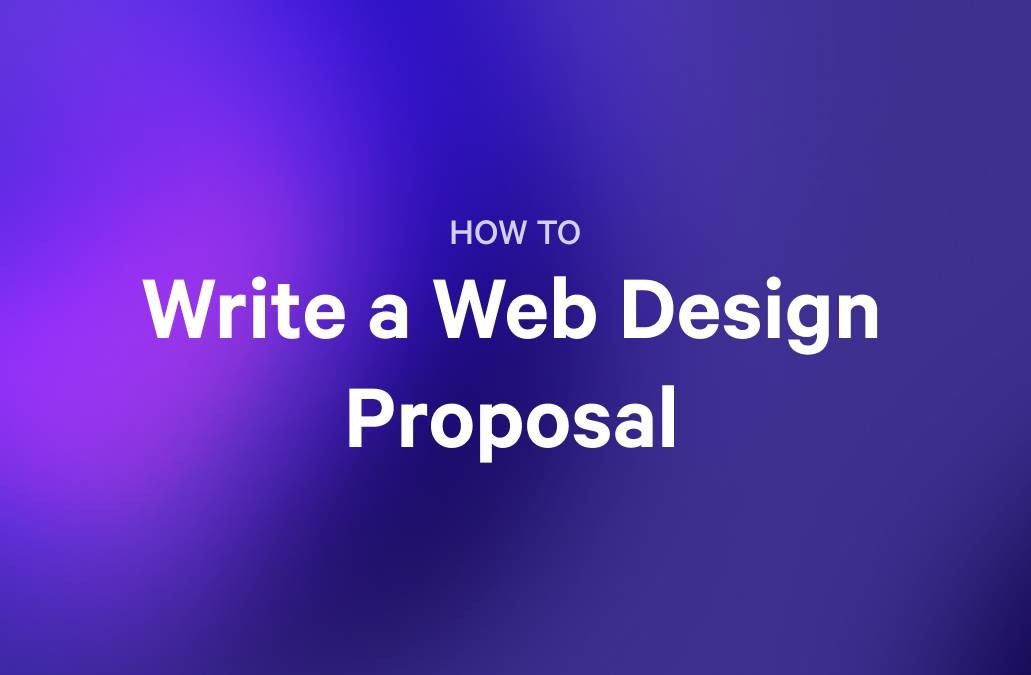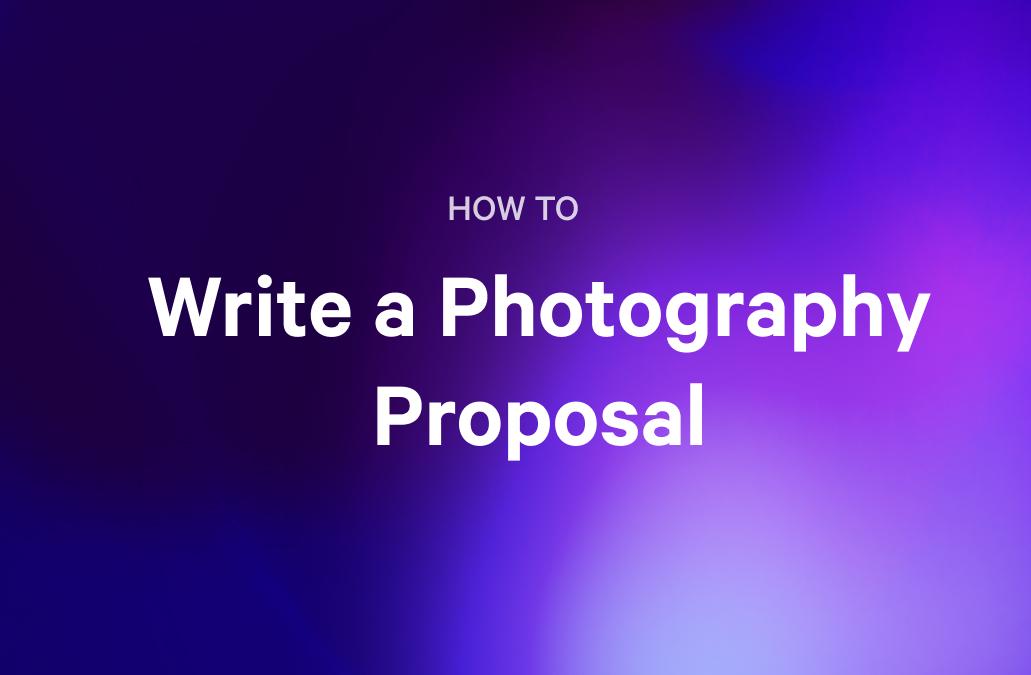If you want to win better clients for your graphic design agency or freelance practice, you need more than just a portfolio. You need to show your work's intended impact on prospective clients' businesses, how you can help them grow, and the value you provide.
Graphic design sales proposals can help you close deals with ideal clients, but you must ensure they're compelling enough to get to yes.
What is a graphic design proposal?
A graphic design proposal is a document graphic designers or design-focused agencies use in their sales process to communicate their ideas, scope of work, timeline, and cost estimates for a potential project. It is an essential tool in securing new clients and projects as it outlines the creative concepts and strategies that will be used to solve the client's needs.
This document aims to close sales deals and set the right expectations for both the agency and the client.
Read next: How to write an interior design proposal
Steps to write a graphic design proposal: Key elements to include
There's no universal, one-size-fits-all recipe for writing winning graphic design proposals.
However, there are ways to ensure your sales proposal is compelling, enticing, and effective.
Below are the steps you need to take and some of the key elements that should be included in your graphic design proposal:
- Executive summary
- Project scope and goals
- Visual style guide
- Samples and case studies
- Design process
- Deliverables
- Success metrics
- Company and team information
- Pricing
- Next steps
1. Research your customer's business
Understanding your client's business is an essential first step in crafting a persuasive graphic design proposal. This knowledge shows your potential clients that you see them as more than just another project but as a unique entity with specific needs and goals.
To do this, investigate their industry, competitors, and target audience. Look at their current visual brand and how they communicate with their customers. This step will not only give you a better understanding of what they may need from a design perspective but also offer insights into how your design can help them stand out, increase their market reach, or enhance their brand image.
Once you're done with this, move on to your prospect's current designs:
- Do they match up against industry standards?
- Are they memorable and appealing?
- Are they following design best practices?
- Are they in tune with what your prospect's main messaging is?
These kinds of questions will help you assess your potential customer's current state -- and inform your strategy as well.
2. Write a compelling executive summary
If sales proposals were social media posts, the executive summary would be your "hook" -- the part that compels people to read on and take action. It should provide highlights of what your potential client can expect from your proposed design solution:
- What inspired the concept?
- What impact will it have on their business?
- Why are you the perfect fit for this project?
This is your chance to clarify things for your prospect, get their attention, and make a strong case for why you are the best choice for their design needs. If you're struggling to write this early in the process, you might consider making this first section of your proposal the last thing you work on, once you've compiled all of the information.
3. Define the project scope and goals
This section of your graphic design proposal should outline what exactly you’ll be doing for your client, answering questions like:
- What specific services will you provide?
- How long is the project expected to take?
- What is the timeline for deliverables?
- What is the budget for the project and what are your payment terms?
Clearly defining the project scope and goals sets realistic expectations for both parties and ensures there are no misunderstandings later on. This section should also include a breakdown of costs, including any additional or optional services, and your payment terms.
4. Create and share a visual style guide
Show your prospect you mean business! Create a visual style guide to give them a taste of what your final design will look like. This can include color palettes, example typography, and other elements that will help them visualize the final product. You don't want to invest too much time in this until you've won the business, so for the purpose of this proposal make sure you're just giving your prospect a taste of what's to come if they decide to work with you.
5. Include relevant samples and case studies
Examples give you an opportunity to show off your skills, and expertise and instill confidence in your potential client. Make sure to choose work that is relevant to the project at hand and demonstrates your ability to deliver high-quality designs.
6. Walk the prospect through your design process
After showing off some examples of your designs, it's essential to outline the design process. This step involves clearly articulating your creative process, illuminating how you transform initial concepts into final designs. Include when you'll present creative concepts and how many rounds of revision are included at each step.
Remember, your proposal is not just about selling your design services; it's about selling the experience of working with you. Illustrating your design process effectively can show potential clients why that experience is worth investing in.
7. Outline your deliverables
In this section of the graphic design proposal, you're expected to give a clear and detailed description of what the client will receive upon the completion of the project. Your deliverables could be anything from the final design files in various formats to the original source files, and a comprehensive style guide. Mention each deliverable along with a brief description of its relevance. For instance:
- Final design files: This includes the finished design items in high-resolution formats, such as JPEG, PNG, PDF, etc. These are the files your client will use for their marketing and branding purposes.
- Editable source files: The editable versions of your designs (probably in AI, EPS, PSD formats) allow your client to make minor changes in the future, if needed, without requiring your assistance.
- Style Guide: The style guide is a document that outlines the project's branding elements like logo usage, color palette, typography, imagery, etc. It ensures consistency in the client's brand representation across different platforms.
Remember also to add information on what you don't include, like a fourth round of edits, unique, custom illustrations, copywriting, etc., if they're not part of your package. This will help set clear expectations and prevent confusion or misunderstandings later.
8. Explain success metrics
Measuring success in graphic design can be difficult, but it's important to provide your clients with some metrics that will help them evaluate the effectiveness of your work. These could include:
- Timely delivery
- Increased brand recognition or perception
- Increase in leads or sales
- Positive customer feedback or reviews
By setting measurable goals and success metrics, you can showcase the impact and value of your design work, helping to build long-term relationships.
9. Write about your company and team
Your graphic design proposal should also include a brief overview of your company and the team members who will be working on the project. This could include their qualifications, experience, and relevant skills.
Introducing your team can add a personal touch to your proposal and allow potential clients to get to know you better. It also shows that you have a strong team to handle their design needs effectively.
10. Provide a cost breakdown
Break down how much everything costs, what each item is quoted as, and any additional costs associated with the project. This will help clients understand where their money is going and what they get in return for their investment.
Make sure to be transparent about your pricing, including any potential extra charges or fees that may come up during the project. This helps to build trust and avoid any misunderstandings down the line.
11. Conclude with the next steps
Your proposal should have compelled the prospect to move forward with your services by now. Make it easy for them by clearly outlining the next steps and how they can get started with you. This could be as simple as having them sign a contract or schedule a call to discuss further details.
Free graphic design proposal template
Our graphic design proposal template is designed to help you create a professional and persuasive proposal that will win over potential clients. We have included all the sections you need to have better sales conversations with your prospective clients and improve sales performance:
- An executive summary
- Your priorities
- 12-month goals
- Your approach to design
- Portfolio samples
- Pricing Breakdown
- eSignature field
You can grab this template, adjust it to your branding and your customer's needs, and use it to start closing deals today. You don't need any coding or technical skills to create a professional and polished web-based document.
Top tips for nailing your graphic design proposal
Keep it concise
Qwilr analysed over 1,000,000 proposals sent through our platform and discovered that long proposals are killing your acceptance rate. In fact, proposals that are 6 pages or less are 66% more likely to get accepted, while proposals of 12 or more pages were mostly in the rejection bucket.
Cut the fluff and get to the point. Show the client what they want to see, in the most compelling way possible.
Consider the message and audience carefully
Any decent graphic designer can throw together a beautiful design. What sets you apart? Your ability to conceptualize the brand, to deeply understand and represent the messaging. Research your prospects, the brand story, their audience, and key messaging so that you can present a proposal that resonates with clients.
Make it easy for clients to give an official ‘yes’
Nothing slows down a deal than back-and-forth paperwork, separate invoicing and contracts, hard-copy proposals for signing and follow-up payments.
If clients are excited about your proposal and ready to hit accept, there should be no friction. Create web-based proposals that include legally-binding e-signature fields, formal agreements, and embedded payments.
With Qwilr, you can collapse multiple steps into one, smooth experience for your buyer. They can accept, sign, and pay all in one document. Cha-ching.

Avoid these common graphic design proposal mistakes
At Qwilr, we’ve analyzed 1,064,667 proposals to identify what sets successful submissions apart from those that get overlooked. The findings reveal the mistakes that sink deals—and how you can steer clear of them.
Check out our quick video for a data-backed breakdown of the biggest errors (and how to avoid them):
The top proposal pitfalls to watch out for:
Overloading your proposal
Proposals with six pages or fewer are 66% more likely to win approval. Trim the unnecessary details and focus only on the content that matters to your audience.
Neglecting timely follow-ups
Engaging multiple stakeholders within five days nearly doubles acceptance rates (1.9x). Leverage proposal analytics to see who’s reading, then time your follow-ups to help champions loop in decision-makers quickly.
Sending flat PDFs
Attachments alone don’t cut it anymore. Interactive proposals can increase acceptance by up to 200%. Add ROI calculators, dynamic pricing tables, and embedded data to keep prospects engaged and make your proposal memorable.
Polish your proposals with Qwilr
The best sales proposals flow like stories: they focus on the customer and what their pain points are and offer your services as a way to support the prospect's needs. Be concise, compelling, and polish your proposal with great design skills.
Remember: proposals are not just a document; they're a conversation starter. Use them to showcase your work and build long-lasting relationships with potential clients. And don't forget to follow up! Your proposal is just the start of the customer journey - be sure to keep in touch and continue building that relationship even after the project is completed.
Ready to create a graphic design proposal template that you can tailor to the needs of any potential client? Qwilr is here to help you get started in minutes so you have more time to do what you love - design great work!
About the author

Marissa Taffer|Founder & President of M. Taffer Consulting
Marissa Taffer is the Founder & President of M. Taffer Consulting. She brings over 15 years of sales and marketing experience across various industries to a broad range of clients.


